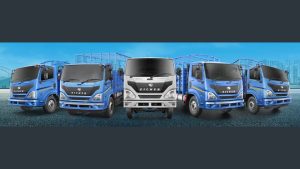
INDIA hopes to become energy-independent by 2047 and hydrogen fuel cell vehicles will play a major role in achieving this target. Hydrogen fuel trucks and buses help reduce pollution as they produce zero CO2 emissions and are more efficient than traditional modes of transport. To tackle the pollution problem many companies like Tata, Reliance, and other government organizations are working on building hydrogen-powered trucks and buses.
Along with India, other countries around the world are also focusing on hydrogen vehicles. In Europe, there is a plan to add 1200 hydrogen buses and 150 hydrogen trucks by 2025. China is also planning to add 50,000 hydrogen vehicles by 2025.

TATA PRIMA H.55 S
Prima H. is a truck for the transportation of goods in an eco-friendly way with less cost of operation. The truck has a Cummins 6.7L H2 engine with a power of 290HP which produces 1200 Nm torque. The truck has low maintenance as compared to diesel-powered vehicles. The vehicle is used in the construction industry for cement, coal, and cargo transportation.
Technical Specifications


TATA STARBUS EV FUEL CELL
The fuel cell bus is India’s first hydrogen fuel cell bus with zero emissions and noiseless operations. The bus is equipped with features like a Driver Monitoring System, Lane Departure Warning system, and tire pressure monitoring system. The range of the hydrogen bus is 250 to 300 km and has a top speed of 70-75 kmph.
Technical Specifications

Other Companies And Government Initiatives
Reliance Industries is also working on converting around 5000 existing internal combustion engine (ICE) powered trucks into hydrogen ICE trucks.
Ashok Leyland and Dailmer India are also actively working on hydrogen trucks and buses. Both companies are looking into introducing hydrogen fuel cells in various categories.
Government initiatives for other eco friendly mode of transportation like funicular railway and use of ethanol as fuel which will help reduce pollution.
Indian Army has also partnered with Indian Oil Corporation Limited to develop hydrogen fuel cell technology in heavy-duty mobility vehicles.
Conclusion
The hydrogen fuel cell is the future of the transportation industry. There are a lot of government initiatives like INDIA NATIONAL GREEN HYDROGEN MISSION which plans to produce 5 million metric tonnes of green hydrogen per year by 2030. The two most important minerals of hydrogen fuel cells are Platinum and Lithium. Around 70 percent of Platinum is produced in South Africa followed by Russia which produces around 16 percent. So it’s important to develop good international relations so that we can procure the required raw materials. To become self-dependent in the energy sector it’s important to focus more on Hydrogen vehicles and reduce the problem of pollution.







